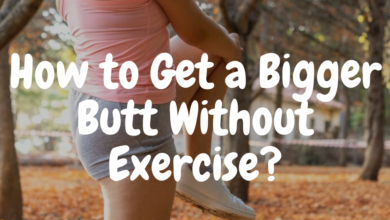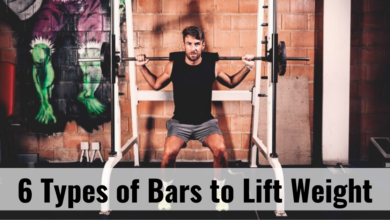7 Best Tricep Short Head Exercises
The triceps brachii muscle, commonly known as the triceps, is a three-headed muscle located at the back of the upper arm. One of these heads, the tricep short head, plays a crucial role in arm extension and overall upper body strength. In this article, we’ll delve into various exercises specifically targeting the tricep short head to help you achieve stronger, more defined arms.
Importance of Training Tricep Short Head
Training the tricep short head is crucial for various reasons exercises . It contributes to arm size and definition, enhances strength and functional movement, and prevents injury. The short head is located on the inner side of the upper arm, making it a key part of the triceps brachii muscle. It is also essential for functional movements involving elbow extension, which require a strong short head for optimal performance. Neglecting the short head can lead to imbalances, affecting both aesthetics and functional strength. Strengthening the short head also helps stabilize the elbow joint, reducing the risk of injuries. It also enhances performance in compound exercises, allowing for greater muscle growth and strength.
Benefits of Lateral Head Triceps Exercises
Exercising the lateral head of the triceps has various advantages:
- Arm Size and Definition: The lateral head of the triceps, positioned on the outer side of the upper arm, has a considerable impact on arm size and definition. Targeting this muscle with specific exercises helps increase mass and shape in the triceps, which improves overall arm appearance.
- Enhanced Arm Strength: Strengthening the lateral head of the triceps is essential for increasing arm strength, especially during elbow extension motions. This comprises pushing workouts such as bench presses, shoulder presses, and dips. A stronger lateral head increases the ability to generate force during these motions, resulting in better performance and muscle growth.
- Balanced Muscle Development: The triceps brachii has three heads: lateral, medial, and long. Neglecting any of these heads can lead to muscular imbalances, affecting both look and function. Targeting the lateral head ensures balanced triceps development, which is necessary for excellent arm aesthetics and upper body strength.
- Improved Arm Functionality: The lateral head of the triceps is essential for a variety of functional actions that include elbow extension. Strengthening this muscle helps improve performance in everyday tasks including pushing, lifting, and carrying goods. It also helps with sports-related motions that demand arm strength and power.
- Injury Prevention: Strengthening the lateral head of the triceps helps to support the elbow joint, which reduces the risk of elbow strains and overuse injuries. Improving muscular strength and stability around the elbow increases joint integrity and resilience during physical activity, lowering the risk of injury.
- Athletic Performance: Strong lateral head triceps muscles are crucial for athletes that compete in activities that require upper body strength and power, such as weightlifting, basketball, and football. Developing this muscle enhances performance in actions such as throwing, pushing, and grappling, leading to overall athletic success.
Incorporating movements that especially target the lateral head of the triceps into your workout program, such as triceps pushdowns, skull crushers, and close-grip bench presses, will assist maximize these advantages and promote overall triceps development.
7 Best Lateral Head Tricep Exercises
1. Close Grip Bench Press
The Close Grip Bench Press is a complex head exercises that primarily works the tricep but also activates the chest and shoulders to varying degrees. It includes employing a narrower hold on the barbell than the typical bench press, putting more focus on the triceps muscles.
Step-By-Step Guide:
- Start by lying flat on a bench press with your back completely supported. Position yourself so that your eyes are exactly below the barbell. To ensure stability, keep your feet firmly planted on the ground.
- Hold the barbell with your hands closer together than shoulder-width apart. Your hands should be 6 to 12 inches apart, depending on your comfort level and shoulder flexibility. Use an overhand grip (palms facing away from you) and wrap your thumbs over the bar.
- Lift the barbell from the rack with your arms and shoulders. Hold the barbell precisely over your chest, arms fully extended. This is your starting position.
- With control, lower the barbell toward your chest, maintaining your elbows close to your body. Bring the barbell to the lower region of your chest, right beneath your nipples. Keep your core engaged and your back flat against the bench.
- Once the barbell has touched your chest, extend your arms and push through your hands to return it to its initial position. Keep your elbows tucked in as you press the barbell up. Exhale as you lift the barbell up.
- Continue pressing until your arms are fully extended, but avoid locking out your elbows at the top of the action. Maintain tension in your triceps throughout the workout.
- Lower the barbell back to your chest and press for the appropriate amount of repetitions.
- Once you’ve finished your set, carefully return the barbell to the rack.

2. Tricep Pressdown
The Tricep Pressdown is a popular workout that works the triceps, which are positioned on the back of the upper arm. It is often conducted with a cable machine equipped with a high pulley and a straight or V-shaped bar attachment. This workout is good for increasing triceps strength and definition.
Step-By-Step Guide:
- Start by setting the cable machine’s high pulley attachment and attaching a straight or V-shaped bar to the cable. Select an adequate weight for your fitness level and attach it to the stack.
- Stand facing the cable machine, your feet shoulder-width apart. Hold the bar with an overhand grip (palms facing down) and hands slightly closer than shoulder width apart. Maintain your elbows close to your sides throughout the workout.
- Hold your arms completely extended, elbows close to your sides, and knees slightly bent. To keep your body stable, engage your core muscles.
- Exhale and press the bar down by extending your elbows until your arms are fully extended and the bar is close to your thighs. Keep your upper arms still and simply move your forearms.
- At the bottom of the movement, halt briefly and squeeze your triceps to increase muscular engagement. Concentrate on feeling the strain in your triceps.
- Inhale and carefully reverse the movement, allowing the bar to rise under control before bending your elbows and returning to the starting position. Keep your movement smooth and controlled throughout.
- Repeat for the required number of repetitions while maintaining proper form and control. For an effective triceps workout, aim for 8-12 repetitions per set.
- If you are experiencing discomfort or strain in your wrists or elbows, you may need to change your grip or use an alternative attachment. Experiment with grip breadth and hand posture to see what is most comfortable and effective for you.

3. Diamond Push ups
Diamond push-ups, often called triangle push-ups, are a version of the standard push-up exercise that focuses more on the triceps and chest muscles. Diamonds push-ups’ distinctive hand placement emphasizes the triceps, making them an ideal workout for arm strength and contouring. Here’s a step-by-step guide for doing diamond push-ups:
Step-By-Step Guide:
- Get into a plank position on the floor. Place your hands together, just behind your chest, forming a diamond formation with your thumbs and index fingers. Your wrists should be just below your shoulders, and your entire body should be in a straight line from head to heels.
- Engage your core muscles by bringing your navel toward your spine and bracing your abs. This will help you steady your body and stay in perfect alignment during the activity.
- Bend your elbows and slowly lower your body to the floor, keeping them close to your sides. Maintain a straight back when lowering yourself, and avoid drooping your hips or arching your lower back.
- Lower your chest toward the diamond shape made by your hands, trying to get as near to them as possible without touching them.
- Pushing Phase: When you’ve reached the bottom of the movement with your chest approaching the diamond form, use your palms to extend your arms and return to the beginning position. Keep your elbows close to your sides while pushing up.
- At the height of the exercise, fully extend your arms but do not lock your elbows. Maintain tension in your triceps and chest muscles throughout the workout.
- Exhale as you push yourself up off the floor, then inhale as you lower yourself back down. Controlled breathing is essential for maintaining rhythm and stability.
- Perform the movement for the desired number of times, aiming for 8-15 reps depending on your fitness level and strength. If you’re new to diamond push-ups, begin with less repetitions and gradually increase as your strength improves.
- If diamond push-ups are too difficult initially, you can alter.
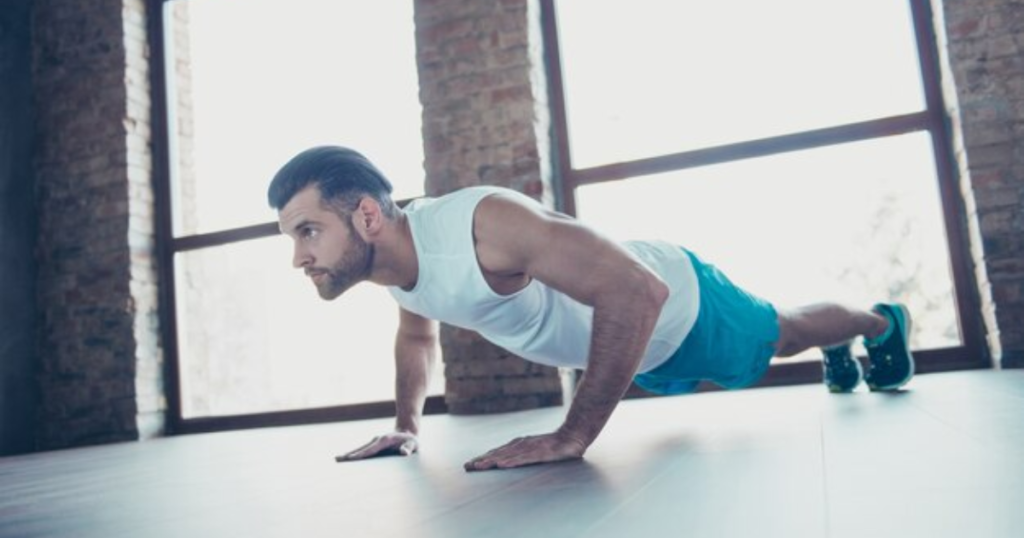
4. EZ Bar Skull Crushers
EZ bar skull crushers, also called EZ bar lying triceps extensions, are a popular strength training exercise that works the triceps muscles. This exercise can assist develop triceps strength and muscular mass, which are necessary for a variety of pushing actions such as bench press and overhead press.
Step-By-Step Guide:
- Start by loading an EZ barbell with the necessary weight. Lie down on a flat bench, back against the bench and feet firmly planted on the floor.
- Grip the EZ bar with an overhand grip, keeping your hands slightly closer than shoulder width apart. Your hands should be facing away from you, with your thumbs wrapped around the bar.
- Fully extend your arms above your chest while maintaining your elbows slightly bent. Your elbows should be pointed to the ceiling, and the barbell should be squarely above your forehead.
- Bend your elbows to slowly lower the barbell towards your forehead while keeping your upper arms immobile. The movement should mimic a “skull crusher” motion, as the exercise’s name suggests. Lower the barbell until it is just above or slightly touching your brow.
- Pause slightly at the bottom of the exercise to feel a stretch in your triceps muscles.
- Contract your triceps to lengthen your arms, then push the barbell back to the starting position. Keep your upper arms still throughout the action and concentrate on using your triceps to move the weight.
- Inhale as you lower the barbell near your forehead, then exhale as you stretch your arms and push it back up.
- Depending on your fitness level and goals, you should perform the desired number of repetitions every set, which is usually 8-12.

5. Dumbbell French Press
The Dumbbell French Press, commonly known as the Dumbbell Skull Crusher, is a classic strength training exercise that focuses on the triceps muscles. It is a great exercise for increasing triceps strength and growth. Here’s a step-by-step guide for performing the Dumbbell French Press.
Step-By-Step Guide:
- Choose an appropriate set of dumbbells to lift with control throughout the exercise. Lie down on a flat bench, pressing your back firmly against it. Hold the dumbbells in an overhand hold (palms facing each other) and raise your arms straight above your chest.
- Keep your feet flat on the ground and bend your knees at a comfortable angle. To maintain stability during the exercise, keep your back flat against the bench.
- Bend your elbows slowly and keep your upper arms stationary and perpendicular to the floor as you drop the dumbbells towards your head. As you lower the dumbbells, make sure your elbows are facing towards the ceiling.
- Lower the dumbbells slowly and steadily, bringing them as close to your temples as possible without touching them. Keep your wrists straight and don’t let the dumbbells fall too far behind your head.
- When you feel a stretch in your triceps, pause briefly at the bottom of the exercise, then exhale and lift the dumbbells back up to the starting position while extending your elbows and contracting your triceps.
- At the top of the movement, fully extend your arms but do not lock your elbows to keep stress on the triceps muscles.
- Complete the required number of repetitions, usually 8-12 per set, while maintaining perfect form and control throughout the exercise.
- When you’ve finished your chosen number of sets and repetitions, carefully lower the dumbbells back to their starting position and slowly sit up. Take a moment to stretch your triceps to relieve any tension or soreness.
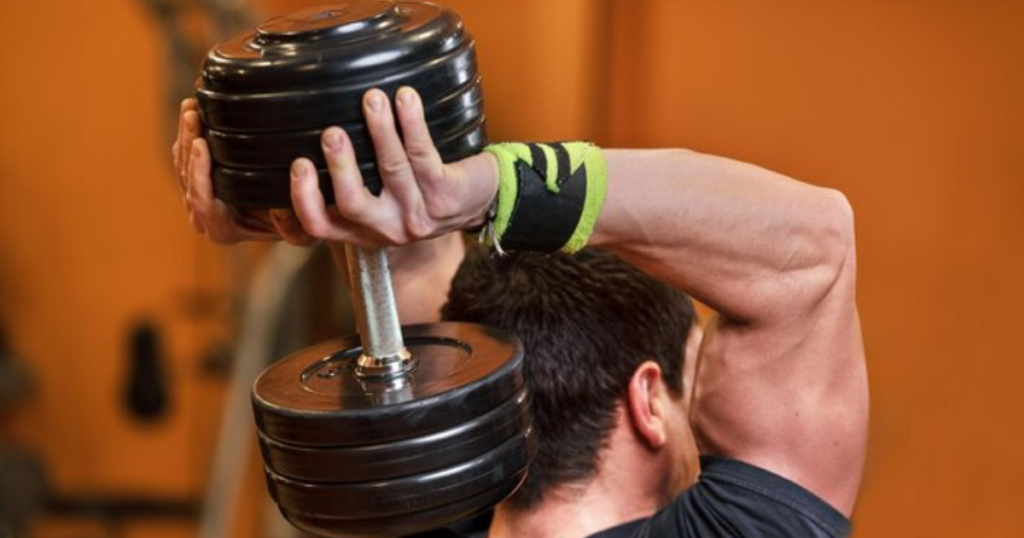
6. Close Grip Dips
Close grip dips are a great compound exercise that primarily focuses the triceps but also works the chest and shoulders to some extent. They are conducted with parallel or dip bars and demand upper-body stability and strength.
Step-By-Step Guide:
- Start by adjusting the parallel bars to a height where you can comfortably grab them while keeping your feet off the ground. The bars should be spaced somewhat broader than shoulder width apart.
- Stand between the bars and use an overhand grip, palms facing inwards. Your hands should be closer together than in a normal dip, with your thumbs wrapped around the bars.
- Support your body by jumping or stepping onto the bars, straightening your arms, and locking your elbows. Your torso should be hanging over the bars, arms fully extended and feet elevated above the ground.
- Inhale and slowly lower your body while bending your elbows. As you fall, keep your elbows tight to your sides and strive to lower yourself until your upper arms are parallel to the ground or slightly lower.
- Don’t swing or jolt your body when descending. Use the strength of your triceps to control the action.
- Exhale and use your palms to straighten your arms and return to the starting position. To maintain muscle tension, fully extend your elbows at the top of the exercise without locking them out totally.
- Aim for 8-12 reps per set.
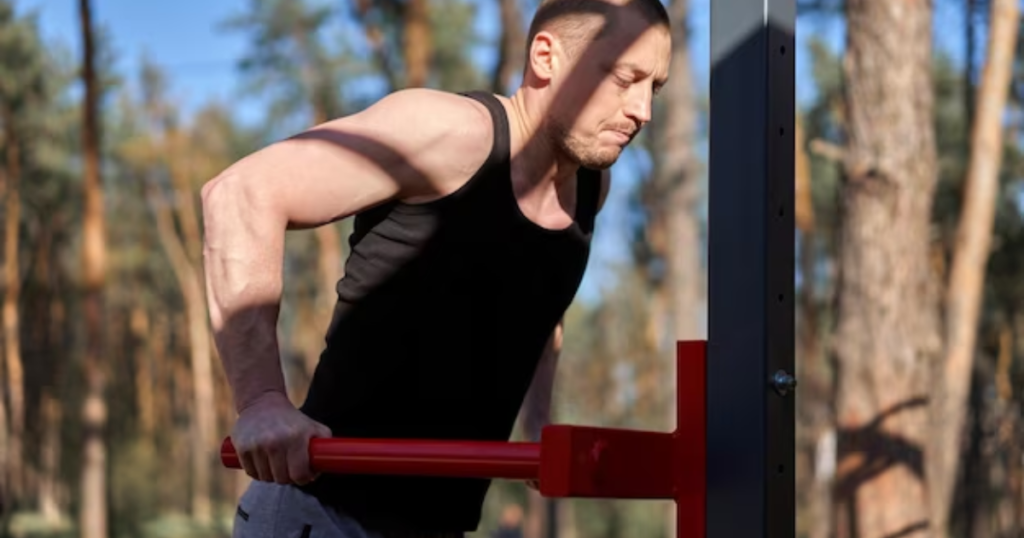
7. Smith Machine Close Grip Bench Press
The Smith Machine Close Grip Bench Press is a version of the standard bench press workout that focuses on the triceps muscles while activating the chest and shoulders to a lesser level. This exercise is done on a Smith machine, which includes a guided barbell track for enhanced stability and safety.
Step-By-Step Guide:
- Adjust the barbell height on the Smith machine so that you can reach it comfortably while lying on the bench. Ensure that the safety catches are in place to keep the barbell from falling too low.
- Sit exactly beneath the barbell. Lie back with your feet shoulder-width apart. Your eyes should be in line with the barbell.
- Reach up and grab it with an overhand grip, little narrower than shoulder width. Your hands should be closer together than in a typical bench press grip, with your thumbs wrapped around the bar.
- To unrack the barbell, completely stretch your arms and lift it off the safety catches. The barbell should be held precisely over your chest, elbows completely extended.
- Inhale and slowly lower the barbell to your chest in a controlled motion. Keep your elbows tight to your body during the exercise, aiming to descend the barbell to the lower area of your chest.
- Exhale and press the barbell back up to the beginning position while extending your arms and squeezing your triceps. Keep your wrists straight and your triceps tight throughout the exercise.
- Repeat the required number of times, ensuring proper form and control throughout each repetition.
- Once you’ve finished your set, carefully return the barbell to the Smith machine’s safety catches.

Anatomy of the Tricep Short Head
The triceps brachii muscle, also known as the triceps, is a large muscle on the back of the upper arm responsible for extending the elbow joint and straightening the arm. It consists of three heads: long, lateral, and short. The short head, located on the inner side of the upper arm, is responsible for elbow extension and straightening the arm. It is active during forceful elbow extension movements like bench presses, triceps dips, and overhead presses. Strengthening the short head is crucial for balanced triceps development, optimal arm strength, and overall upper body function. The triceps brachii is visible from the side and back of the arm, while the lateral and long heads are more visible from the side and back of the arm.
Tricep Short Head Exercises Without Equipment
Sure! Here are some tricep exercises that target the short head of the triceps and don’t require any equipment:
- Diamond Push-Ups: Begin in a regular push-up stance, but bring your hands together right under your chest, producing a diamond shape with your index fingers and thumbs. Lower your body until your chest is almost touching the ground, then push back up to the starting position.
- Tricep Dips: Choose a steady surface, such as a chair, bench, or the edge of a strong table. Sit on the edge, your hands grabbing the surface next to you. Lift your hips off the ground and descend your body by bending your elbows to around a 90-degree angle. Use your triceps to push yourself back to the beginning position.
- Close Grip Push-Ups: Similar to ordinary push-ups, but with your hands closer together, about shoulder width apart. This variation focuses on the triceps more than normal push-ups.
- Bench Tricep Dips: Sit on the ground, knees bent, and back against a stable bench or elevated surface. Place your hands on the edge of the bench next to your hips, fingers pointing forward. Lift your hips off the ground and move your feet slightly out. Lower your body by bending your elbows until your upper arms are parallel to the ground, then push back up to your starting position.
- Bodyweight Skull Crushers: Lie on your back on the ground or a mat. Extend your arms straight up to the ceiling, palms facing each other. Bend your elbows and lower your forearms to the ground, maintaining your upper arms stationary. Return your arms to the starting position until your forearms are parallel to the ground or as far as you can comfortably extend them.
- Tricep Bench Plank: Begin in a plank position, with your forearms resting on a solid surface like a bench or chair. Make sure your body is in a straight line from head to heels. Push through your hands to straighten your arms and engage your triceps. Hold for a moment, then return to your starting position.
Performing these movements with good form and control can efficiently target the short head of your triceps without the use of any equipment. Begin with a few repetitions of each exercise, gradually increasing as you gain strength.
Tricep Short Head Exercises with Dumbbells
Certainly! Here are several dumbbell-based tricep exercises that focus on the short head of the triceps.
- Dumbbell Overhead Tricep Extension: Stand or sit on a bench, holding a dumbbell firmly in both hands overhead. Lower the dumbbell behind your head by bending your elbows but keeping them close to your head. Extend your arms back to the starting position, squeezing your triceps.
- Dumbbell Skull Crushers: Lie on a flat bench with a dumbbell in each hand, arms straight above your shoulders and palms facing each other. Bend your elbows and lower the dumbbells to your temples while keeping your upper arms motionless. Return your arms to the starting position, squeezing your triceps at the top.
- Dumbbell Kickbacks: Stand with a dumbbell in each hand, palms facing in, and bend forward at the hips, bringing your torso almost parallel to the ground. Keep your upper arms close to your sides while extending your elbows and pulling the dumbbells straight back until your arms are fully extended. Hold for a moment, then return to your starting position.
- One-Arm Dumbbell Tricep Extensions: Stand shoulder-width apart and grasp a dumbbell in one hand. Raise the dumbbell above, arm fully extended. Lower the dumbbell behind your head by bending your elbow while keeping your upper arm stationary. Extend your arm back to the beginning position, contracting your triceps.
- Dumbbell Tricep Press: Lie on a flat bench with one dumbbell in each hand over your chest, palms facing in. Lower the dumbbells to your shoulders by bending your elbows while keeping your upper arms stationary. Press the dumbbells back to their starting position, completely extending your arms and squeezing your triceps.
Include these movements in your training program to efficiently target your triceps’ short head using dumbbells. Make sure to employ excellent technique and a suitable weight to challenge your muscles while keeping control throughout the movements.
Tricep Short Head Exercises with Barbell
Certainly! Here are some tricep exercises for the short head that may be performed with a barbell:
- Close Grip Bench Press: Lie on a flat bench and hold the barbell with your hands closer together than shoulder-width apart. Lower the barbell to your chest and keep your elbows tight to your torso. Push the barbell back to the beginning position, squeezing your triceps at the top.
- Skull Crushers: Lie on a flat bench and grasp the barbell with an overhand grip, arms extended squarely over your chest. Bend your elbows and lower the barbell towards your forehead while keeping your upper arms immobile. Extend your arms back to the beginning position while contracting your triceps.
- Barbell Tricep Extension (French Press): Stand with your feet shoulder-width apart and an overhand grip on the barbell, arms stretched overhead. Lower the barbell behind your head by bending your elbows but keeping your upper arms stationary. Extend your arms back to the starting position, squeezing your triceps.
- Barbell Tricep Press: Stand with your feet shoulder-width apart and hold the barbell with an overhand grip. Lift the barbell overhead, arms fully extended. Lower the barbell behind your head by bending your elbows but keeping your upper arms stationary. Extend your arms back to the starting position, squeezing your triceps.
- Barbell Lying Tricep Extension (Nosebreakers): Lie on a flat bench and grab the barbell with an overhand grip, arms extended squarely above your chest. Bend your elbows and lower the barbell towards your forehead while keeping your upper arms immobile. Extend your arms back to the beginning position while contracting your triceps.
Incorporate these exercises into your training program to properly target the short head of your triceps with the barbell. Make sure to employ excellent technique and a suitable weight to challenge your muscles while keeping control throughout the movements.
Importance of Proper Form and Technique
Tricep short head workouts require proper form and technique for various reasons:
- Targeting the Muscle: Using proper form ensures that the desired muscle, in this case the triceps short head, is properly targeted during the exercise. Poor form might cause other muscles to compensate and take over, limiting exercise efficacy and potentially creating imbalances.
- Injury Prevention: Proper form lowers the risk of injury by positioning the muscles and joints in the safest position possible. Incorrect technique, such as employing too much momentum or allowing joints to move out of position, can strain muscles, ligaments, and tendons, resulting in strains, sprains, or other significant injuries.
- Muscle Activation: By using good form, you can ensure that the target muscle is fully stimulated throughout the exercise. This increases muscular engagement and promotes growth and strength improvements in the triceps short head.
- Efficiency and Effectiveness: Using proper form allows you to do exercises more efficiently and effectively. Using the proper movement patterns allows you to lift higher weights with greater control, resulting in increased muscle stimulation and better long-term outcomes.
- Long-Term Progress: Consistently employing good form and technique results in long-term progress and prevents plateaus. By lifting safely and effectively, you may progressively raise the weight and intensity of your workouts without risking injury, allowing you to constantly push your muscles and make progress over time.
Overall, focusing on good form and technique in tricep short head exercises is critical for increasing muscle development, avoiding injury, and making long-term progress in your fitness quest.
Tricep Short Head Workout Routine
Here’s a tricep short head workout routine that you can follow:
Warm-up:
- 5-10 minutes of light cardio, such as jogging, cycling, or brisk walking.
- Arm circles, shoulder rolls, and tricep stretches are some examples of dynamic stretches for the arms and shoulders.
Main Workout:
1. Close-Grip Bench Press:
- Three sets of 8-10 repetitions.
- Lie on a flat bench and hold the barbell close together (approximately shoulder width apart).
- Lower the barbell to your chest and keep your elbows tight to your torso.
- Push the barbell back to its initial position while fully extending your arms.
2. Cable Tricep Pushdown:
- Three sets of 12-15 repetitions.
- Use a straight bar or rope attachment for the cable machine.
- Stand facing the machine, with your knees slightly bent and your core engaged.
- Keep your elbows close to your sides and press the cable attachment down until your arms are fully stretched.
- Control your weight as you return to the starting position.
3. Overhead Dumbbell Tricep Extension:
- Three sets of 10-12 repetitions.
- Sit on a back-supporting bench and hold a dumbbell overhead with both hands.
- Bend your elbows to lower the dumbbell behind your head.
- Extend your arms and raise the weight back to its starting position, concentrating on the tricep contraction.
4. Cable Tricep Kickbacks:
- Three sets of 12-15 repetitions per arm.
- Attach a single handle to the cable machine’s lower pulley.
- Stand facing the machine, one hand on the handle, and step back to produce tension in the cable.
- Extend your arm backward, straightening it completely while keeping your elbow still.
- Squeeze your triceps at the peak of the movement before returning to the beginning position.
5. Cool-down:
- 5-10 minutes of gentle cardio or stretching, concentrating on the arms and shoulders.
Remember to select weights that will challenge you within the recommended rep ranges while keeping appropriate form. Allow enough break between sets (60-90 seconds) and listen to your body to avoid overtraining or injury.
Common Mistakes to Avoid for tricep short head exercises
Here are some typical pitfalls to avoid when doing triceps short head exercises:
- Using overly Much Weight: Avoid using overly heavy weights, as this can cause poor form and raise the chance of injury. Choose a weight that will allow you to maintain perfect form throughout the workout.
- Allowing Elbows to Flare Out: During tricep workouts, keep your elbows close to your body to target the muscle’s short head. Allowing your elbows to flare out decreases attention on the triceps while increasing stress on the shoulders and elbows.
- Using Momentum: Avoid using momentum to lift the weight because it diminishes the exercise’s effectiveness and increases the risk of injury. Instead, concentrate on regulating the movement and contracting the triceps over the full range of motion.
- Not Fully Extending the Arms: To maximize tricep activation, ensure that your arms are fully extended at the bottom of each repetition. Avoid stopping short of full extension, as this reduces the exercise’s effectiveness and can lead to muscular imbalances.
- Neglecting Proper Breathing: When performing tricep exercises, remember to breathe properly by exhaling as you exert force (for example, pushing the weight away during a pushdown) and inhaling as you return to your starting position. Proper breathing helps to stabilize the core and improves performance.
- Overlooking Range of Motion: To fully engage the muscle fibers, perform tricep movements with a full range of motion. Avoid decreasing the range of motion or cutting corners, as these might reduce muscle activation and slow growth.
- Ignoring exhaustion or Pain: Listen to your body and don’t push through extreme exhaustion or pain. Overtraining can cause damage and slow growth. If you encounter discomfort in addition to normal muscle fatigue, halt the exercise and review your form or lessen the weight.
By avoiding these frequent mistakes and focusing on good form and technique, you may increase the efficiency of your tricep short head exercises while lowering your risk of injury.
Conclusion
Including a range of tricep short head exercises in your training regimen is critical for obtaining balanced arm growth and functional strength. By emphasizing good form, technique, and progressive loading, you may successfully target and improve this vital muscle group.
Frequently Asked Questions
What is triceps short head?
The tricep short head is a component of the tricep muscle that is found on the back of your upper arm. It is one of the three muscles in your triceps.
Why should I work my triceps short head?
Working on your triceps short head strengthens your arms and enhances your capacity to push items, such as opening doors or getting up from a seated posture.
What are some exercises that target the triceps’ short head?
Tricep pushdowns, tricep kickbacks, and overhead tricep extensions are among exercises that target the triceps’ short head. These exercises isolate and develop your triceps.
How often should I perform triceps short head exercises?
It’s important to give your muscles time to relax and recuperate between workouts, so try to practice tricep exercises 2-3 times each week, with at least one day off between each session.
Can I perform triceps short head exercises at home?
Absolutely! Many tricep workouts may be done at home using only a pair of dumbbells or your own body weight. Tricep dips using a chair or bench, tricep pushups, and overhead tricep extensions with a dumbbell are all excellent choices for home training. Just remember to practice good form to avoid harm.

